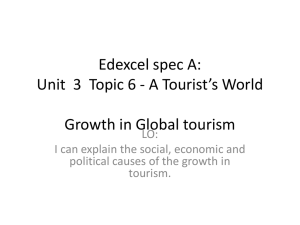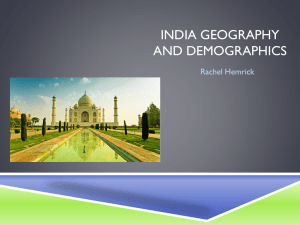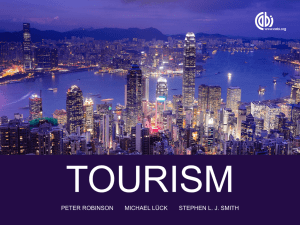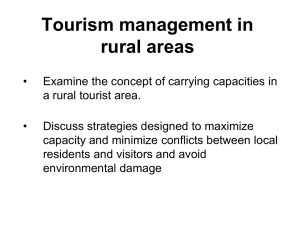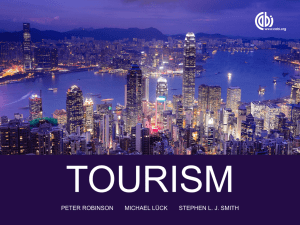chapter Two
advertisement
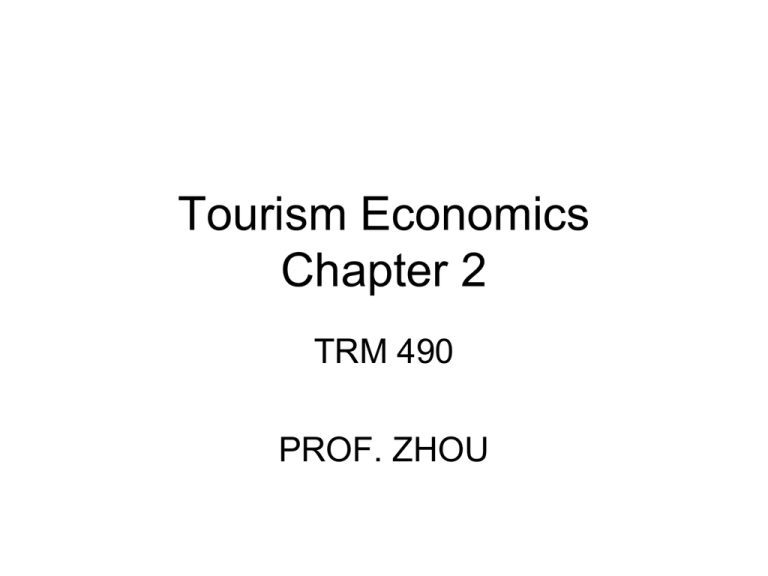
Tourism Economics Chapter 2 TRM 490 PROF. ZHOU Chapter 2: Economics as Applied to Tourism • Major Economic Theories – Adam Smith: concepts of supply and demand, productivity growth over time, division of labor and specialization for productivity – T.B. Say: Say’s Law: the economy as a whole generates exactly the right amount of income to allow people to pay for the sale of all the goods that have been produced – John M. Keynes: increased government spending in the economy is necessary to support struggling economies. Chapter 2: Economics as Applied to Tourism(2) • Reagan’s supply-side economic policy – Government goes to debt – Cut taxes to spur investment and buying Chapter 2: Economics as Applied to Tourism(3) • Economics defined: – The study of the choices people make in using their scarce resources to meet their needs and wants. • Economic choices – – – – What goods and services should be produced How they should be produced Who should do which jobs For whom the results of economic activity should be made available. – These choices are made because of scarcity. Chapter 2: Economics as Applied to Tourism(4) • Factors of production: – Inputs of labor, capital, natural resources • Opportunity cost: – Productive resources that are used to satisfy one want can’t be used to satisfy another at the same time – Production of any good or service entails forgoing the opportunity to produce something else in stead. – In economic terms, everything has an opportunity cost – The opportunity cost is its cost in terms of the forgone opportunity to pursue the best possible alternative activity with the same time or resource. – Care must be taken when measuring the cost as money: not all sacrificed opportunities take the form of money. Chapter 2: Economics as Applied to Tourism(5) • Supply and demand: – The law of supply and demand • The law of demand states that an inverse relationship exists between the price of a good or service and the quantity of the good or service that buyer demand, other things being equal. (see figure2-1, p29) • Other factors: competition, other related business activities (airline price increase, for example), consumer’s disposable income, popularity of the destination or service and the public’s confidence about the future economy. See figure 2-2,p29 Chapter 2: Economics as Applied to Tourism(6) • The law of supply – It states that a direct relationship exist between the price of a good or service and the quantity of good or service that producers supply, other things being equal. (see figure 2-3, p31) Chapter 2: Economics as Applied to Tourism(7) • Equilibrium Point – The price at which the quantity demanded equals the quantity supplied – The equilibrium of supply and demand is stationary in the sense that once the equilibrium price is reached, it tends to remain the same as long as either supply nor demand shifts. – When the price is below equilibrium, the quantity demanded exceeds the quantity supplied, buyers offer higher prices and vice versa. Chapter 2: Economics as Applied to Tourism(8) • Supply and Demand of tourism products – Hotel: it takes longer time to build and supply can exceed demand or vise versa – Restaurants: over supply due to easy entry – Airlines: fierce competition with price wars—a complicated picture – Cruise lines: doing well due to marketing – Rental cars: supply can be more easily adjusted. – Travel agencies: over supply due to easy entry. Chapter 2: Economics as Applied to Tourism(9) • Factors influencing supply and demand – On one hand, there is a relationship—a change in one results in a change in the other – On the other hand, the relationship is heavily influenced by other factors, mainly, marketing efforts and skills and human motivation – Marketing efforts and skills: matching the products and services to the needs and wants of the consumers; the same hamburger sold with different prices and demand. – Human motivation: conspicuous consumption by Thorstein Veblen (fig 2-5, p35): the practice of purchasing goods or services because of the status they might bring (status seekers) Chapter 2: Economics as Applied to Tourism(10) • Economists like to classify goods and services into those that are preferred and those that are non-preferred. • Travel is seen as a “preferred superior service” in that more is undertaken as incomes rises • Elasticity of demand for tourism – Elasticity: sensitive to price changes or the willingness to pay – Tourism elastic or inelastic? Depending on the affluence of the traveler and the reason for the trip. – TRs (total revenues: are equal to the price (P) of the good or service times the total quantity sold (Q). – So the concept of the price elasticity is very important to the suppliers of the tourism products and services – If the price elasticity is known, a supplier can increase the TRs by making adjustment to the price of the product Chapter 2: Economics as Applied to Tourism(11) • Elasticity of Demand for Tourism – Elasticity (sensitive to price change) of tourism demand varies considerably and depends partly on the affluence of the traveler and the reason for the trip. – Elasticity is also about the degree to which the consumers are willing to pay for certain product or the willingness to pay – Price elasticities are important for the suppliers of the tourism products and services, since they can have an impact on their total revenues (TRs of sellers in a market are equal to the price (P) of the good or service times the total quantity sold Q ) – If the price elasticity is known, a tourism product supplier can increase total revenues by making an appropriate adjustment to the price of the product. Chapter 2: Economics as Applied to Tourism(11) • Factors (determinants) influencing price elasticity – Availability of equivalent substitute products – The relative importance of the product in a spending budget – The amount of time available to adjust to the price change – The status of the product as a necessity or luxury Chapter 2: Economics as Applied to Tourism(12) • Utility of tourism consumption – The demand for tourism is influenced by the economic concept of utility: the benefit or satisfaction that a person gets from the consumption of a good or service – The concept of Utility is an abstract concept such as the concept of travel experience – Attempts have been made to quantify the concept of utility (see page 36-37 for examples) Chapter 2: Economics as Applied to Tourism(13) • Total utility: the total satisfaction that a person gets from the consumption of goods and services. – It is limited by the amount of disposable income available, the price of the desired goods and services, and in many cases, the time available to consume the desired products • Marginal utility: the change in total utility resulting from a one-unit increase in the quantity of a good or service consumed. • The principle of diminishing marginal utility: there may be a diminishing satisfaction per additional unit of the product consumed (the benefit of traveling more than once a year might be diminished due to fatigue and other factors) Chapter 2: Economics as Applied to Tourism(14) • Currency exchange rate: the price of one currency in terms of another • Appreciation: an increase in the value of a currency • Depreciation: a decrease in its value Chapter 2: Economics as Applied to Tourism(15) • Balance of Payments: a record of international transactions – In-payments and out-payments are two parts of the balance of payments statement • In-payment include exports of goods and services, unilateral transfers, and inflow of capital in various forms • Out-payments include imports of goods and services, unilateral transfers, and outflow of capital in various forms. – Surplus: in-payments exceed out-payments – Deficit: out-payments exceed in-payments Chapter 2: Economics as Applied to Tourism(16) • Implications of currency exchange rate for tourism – When dollar is weak, travelers come to US – When dollar is strong, US travelers go to other countries (see p41 Figure 2-6) – Airlines and other travel providers observe exchange rates closely and price their product and services up or down to avoid losing money – Tour operators try to get guarantees from hotels, ground transpiration operators and other travel providers to that in case an exchange rate makes travel more closely, they are protected from price increase. Chapter 2: Economics as Applied to Tourism(17) • Tourism costs – Too much dependence on tourism is dangerous due to factors such as terrorism, natural disaster, pandemics, social unrest, safety issues, political rivals, religious conflicts, world-wide economic melt-down and others – Social costs: crime, crowding, traffic, air polution, real estate prices change, food prices and the increasing cost of local government services such as police protection – Other social costs include: low wage jobs; employment of illegal immigrants; culture changes due to traveler’s intrusion of different cultures; cost for government rise when immigrants are employed but remit their revenues to their homes abroad. Chapter 2: Economics as Applied to Tourism(18) • Comparative Advantage – There are differences in opportunity costs between various parts of the world, cities, regions, and nations. – A place has a comparative advantage in producing a particular good and can produce that good at a lower opportunity cost than competitors. – Opportunity cost of any action is the best alternative foregone. For some, there is no best alternative, so the opportunity cost can be zero or negligible, e.g. tourism in Bahamas. – Tourism can fit nicely into many economies; it does not have to have it all or have none of it. Chapter 2: Economics as Applied to Tourism(19) • Cost/benefit analysis: an attempt to quantify and compare the pros and cons of a tourism or other venture. • It can cover more than economic consequences of a decision; for example, sociological and psychological costs. See page 47.




